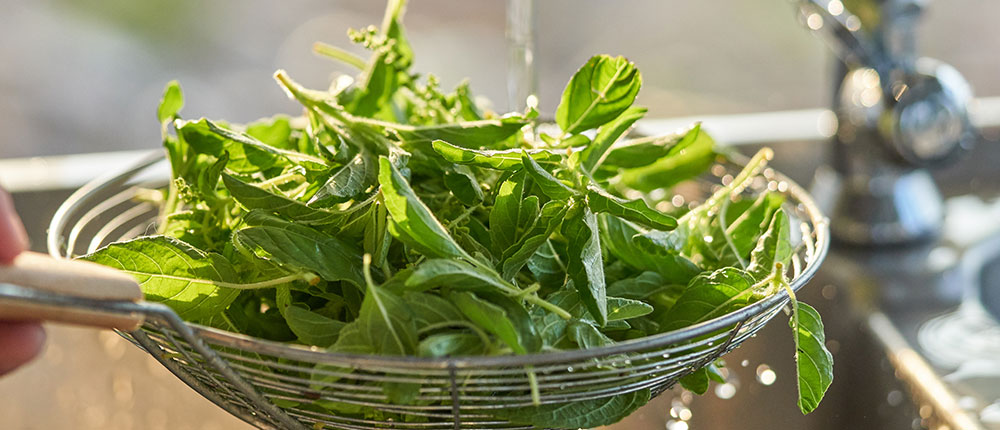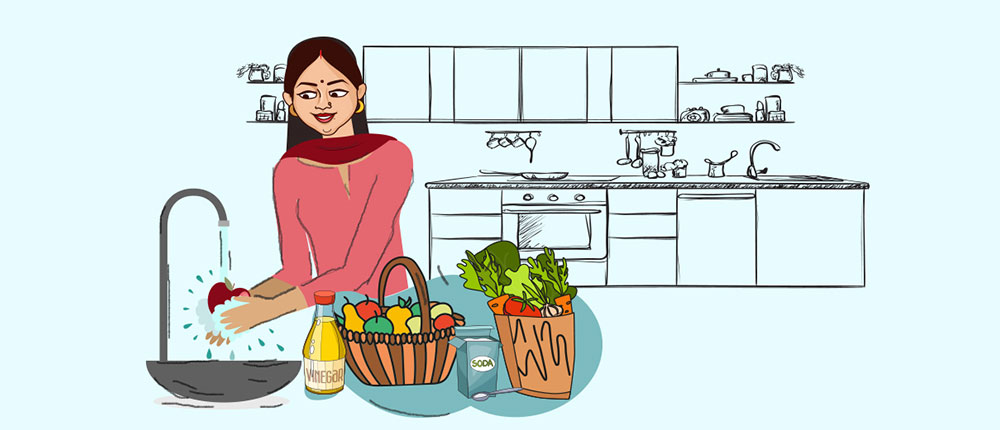Should you wash your fruits and vegetables with soap or detergent or is there a better, natural way to protect what you eat from possible pathogens

Washing fruits and vegetables has always been an important habit to be followed at all times. In the current coronavirus pandemic, it has gained even more importance and it is essential to now take extra care while doing so. Some people are now even switching to vegetable washes, disinfecting liquids and detergents for fruits and vegetables rather than just washing in plain water. While many food scientists advise against the use of chemical based products due to the potential risk of residues and chemical buildup, some suggest that a diluted mild detergent solution can be used with proper rinsing of fruits and vegetables with clean water, especially when chances of viral contamination are higher. For food safety during coronavirus, we have come up with a few tips on how to reduce microbial contamination of raw fruits and vegetables without any strong chemical based products.
1. Keep the kitchen clean and safe
Clean the countertop, cutting boards, and utensils after peeling produce and before cutting and chopping. This is to prevent contaminants from the raw produce from being transferred inside during cutting or peeling. Also wash kitchen surfaces and utensils with hot, soapy water after cleaning vegetables.
Clean wooden chopping boards with vinegar or baking soda to prevent microbial contamination of the same. If consuming non-vegetarian food, ensure that a different set of chopping boards, knives etc. are used in and that they are thoroughly washed with hot water and soap after use.
2. Segregate fruits and vegetables this way
Class 1: Hard-skinned fruits and vegetables: Such as oranges, banana, pumpkin, yams, potato where skin is removed before consumption. Normally we thoroughly rinse these with water and process/consume but under the current circumstances, these items need special rinsing/cleaning procedures.
Class 2: Tender-skinned items: Such as grapes, tomatoes, radish, carrots etc. These are mostly consumed raw.
Class 3: Leafy vegetables: Such as lettuce, spinach, methi and coriander.
Leave aside the plastic bags/paper bags/carry bags etc. for at least 30 minutes after purchase. Avoid bringing the purchase directly on the kitchen top. The goods require further processing before storage and consumption. Keep out of reach of children prior to processing.

3. Further treatment
Class 1 products
Wash hands thoroughly before and after handling raw fruits and vegetables.
Scrub the fruits and vegetables with a brush. Additionally, use baking soda for scrubbing. Then rinse with clean water. In addition to germs, fruits like apples may have a waxy coat introduced to enhance lustre. Make sure to get rid of such additional chemicals from fruit surfaces.
Use mild detergent for washing and soaking Class 1 vegetables only - Use one table spoon of mild detergent in a bucket of water. Soak the fruits and vegetables prior to touching. Rinse thoroughly with cold water several times. While rinsing, keep soaking in tubs to avoid wasting water. Residual detergent can be harmful hence please take precautions.
Class 2 and 3 products
Use one part vinegar in three parts water for washing and then rinse with clean water. Vinegar is also known to reduce the microbes on vegetables and fruits. It works well for produce with smooth skin and for leafy greens.
Vegetables like cauliflower and broccoli that have nooks and crannies can also be soaked in the vinegar solution for at least five minutes and then rinsed with clean water.
Squeeze one large lemon in five litres of water and soak tender vegetables for 15-20 minutes
Or
Prepare a solution of 1/2 cup table salt and three tablespoon baking soda and soak vegetables for 15-20 minutes.
Rinse in plenty of fresh water.
Food grade sodium hypochlorite (NaOCl) solution (100 ppm) can be used to soak vegetables like cabbage for two to five minutes before rinsing with clean water.
Conclusion
During the journey from farm to consumer, fruits and vegetables are handled by multiple people and usually displayed in the open in markets. As a result, they could be contaminated with microbes, soil, dirt, as well as pesticide residues. Cleaning them properly is thus an important step in staying healthy. In light of the COVID-19 pandemic that has taken many lives, preventing contamination and cleaning with natural ingredients assumes even more importance than before.

